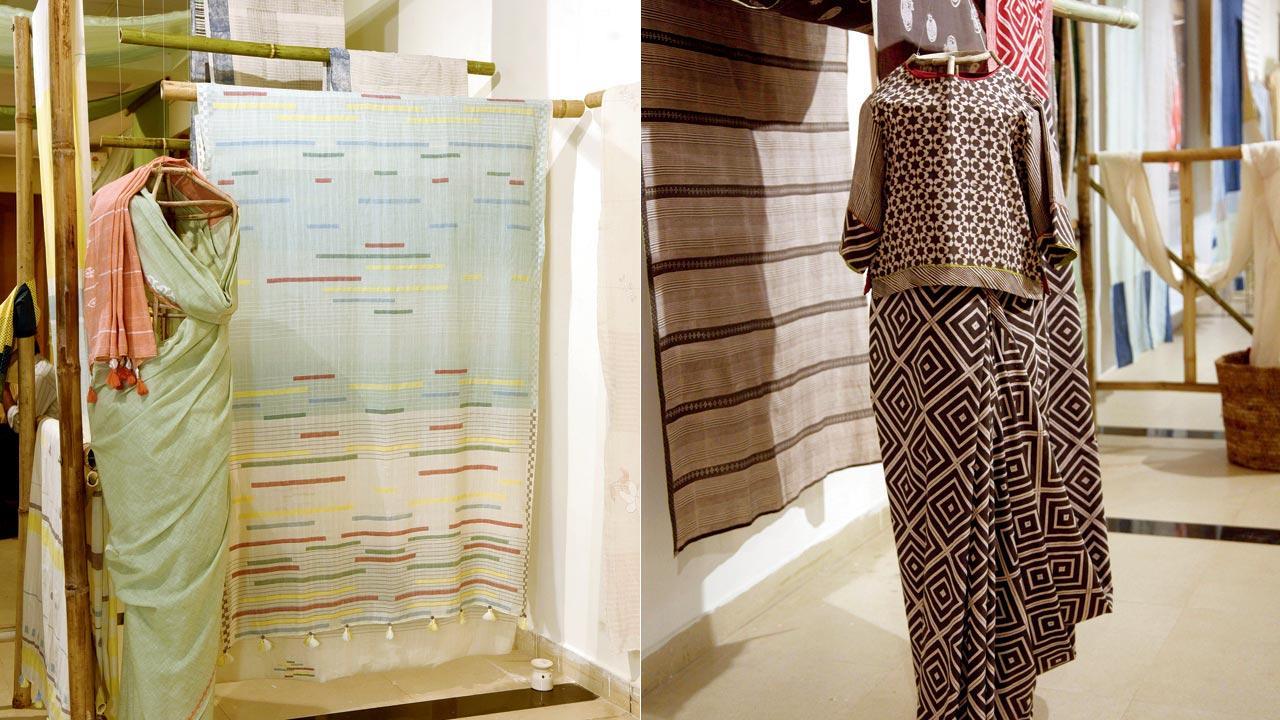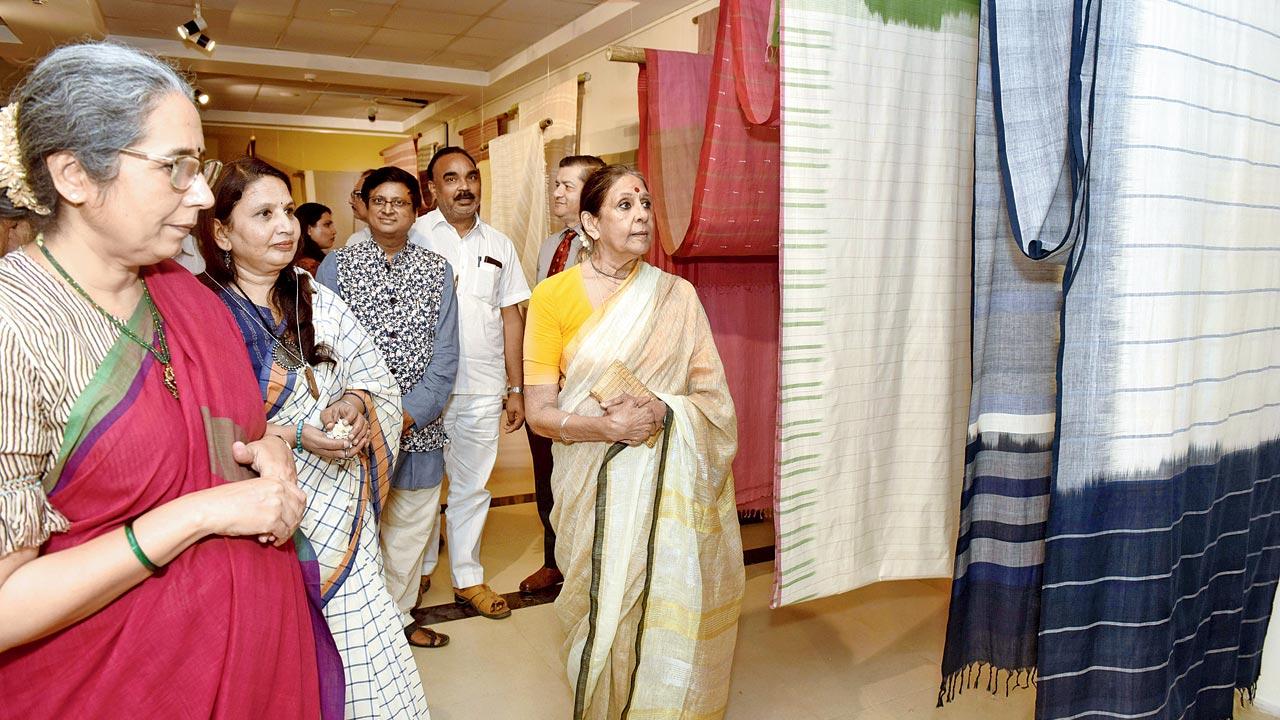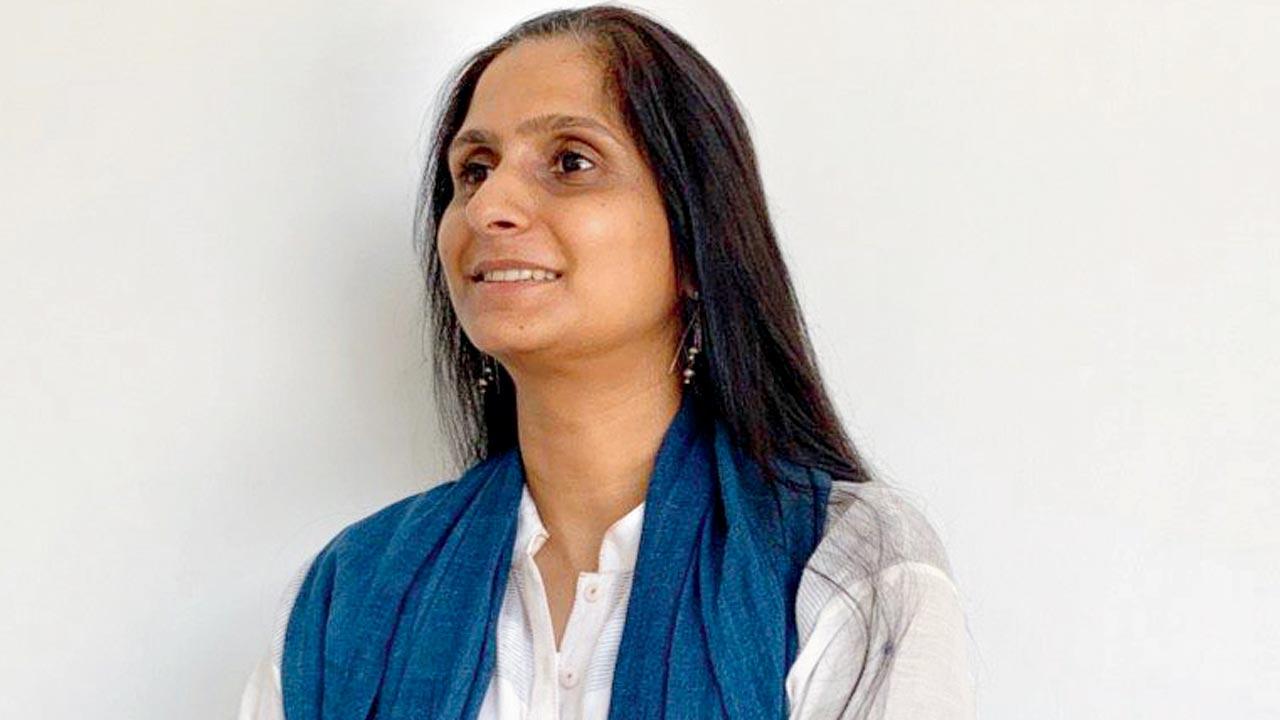An exclusive showcase of 75 sarees upscales khadi’s aesthetic potential with celebratory colours, bead-button embellishments and intricate mukaish and baadla needlework

The Naveli Khadi catalogue positions khadi sarees as trendy, chic and contemporary, while dissociating them from the dull muddiness and limp coarseness that often manifest in many khadi gramodyog stocks
![]() Textile designer Juhi Pandey is based in Shillong, where she heads one of the units of the Centre of Excellence for Khadi (CoEK). But her last seven months have been mostly spent in Guwahati, the city closest to two Khadi institutions in Assam—Tamulpur Anchalik Gramdaan Sangh and Gram Swaraj Parishad Rangia, where she has held extensive artisans’ training in creating organic indigo vat, yarn dyeing, fabric softening, and most importantly, creating a brand identity for sarees made from the natural fibres of the Northeast.
Textile designer Juhi Pandey is based in Shillong, where she heads one of the units of the Centre of Excellence for Khadi (CoEK). But her last seven months have been mostly spent in Guwahati, the city closest to two Khadi institutions in Assam—Tamulpur Anchalik Gramdaan Sangh and Gram Swaraj Parishad Rangia, where she has held extensive artisans’ training in creating organic indigo vat, yarn dyeing, fabric softening, and most importantly, creating a brand identity for sarees made from the natural fibres of the Northeast.
ADVERTISEMENT
Pandey, along with a tiny team of design associates, handheld Tamulpur and Rangia spinners and weavers to make 12 limited edition khadi sarees made of native eri and mulberry silks. The sample sarees form a record of sorts because their weavers had so far only made plain non-coloured chadars, gamchas and mekhalas.
The new-avatar khadi sarees, made in Tamulpur and Rangia, recently journeyed to New Delhi’s Pragati Maidan, as part of the Naveli Khadi display organised by CoEK, a joint initiative of the Ministry of MSME and the National Institute of Fashion Technology; CoEK aims to empower local khadi organisations and strengthen khadi’s footprint. The jori sarees from Assam attracted attention and resulted in orders, leaving Pandey with the work she had hoped for—connecting the client with the artisan. Pandey now spends more time in Shillong, further planning to replicate the success in khadi institutions from other Northeastern states, especially Arunachal Pradesh and Nagaland. “As the first collection of jori goes into production mode after a very positive feedback from designers and customers alike, we will also continue to showcase this collection in Shillong and Nagaland in the following months with the objective to encourage more khadi institutions to adopt new benchmarked techniques and also spread awareness about khadi in the new markets.”
 Political activist and founder of Dastkari Haat Samiti Jaya Jaitly (first from right) inaugurating CoEK’s Naveli Khadi exhibition
Political activist and founder of Dastkari Haat Samiti Jaya Jaitly (first from right) inaugurating CoEK’s Naveli Khadi exhibition
Like the jori series, the Naveli Khadi show includes 75 prototype sarees, aligned under 15 thematic series, from colourful corners of India—Murshidabad to Gondal and Dindigul. The collection underscores the versatility of khadi, its social power and aesthetic potential, the swadeshi connect, but most importantly, the personal stories of creators whose design philosophy reflects in the making of the fabric.
The 135-page Naveli Khadi saree catalogue, which this columnist previewed to understand the CoEK philosophy, positions the sarees in a trendy, chic and contemporary league of their own. It does something more too—it dissociates khadi from the dull muddiness and limp coarseness that manifest in many khadi gramodyog stocks, where the counter staff is often on a mission to discourage sale. The catalogue connects khadi with women’s determination, resilience, wisdom and strength. Interestingly, the saree series from Tamil Nadu is called Thunivu, which translates to courage.
The saree catalogue honours experimentation and creates new pathways. It spells out multiple possibilities of marrying the rectangular handspun six yard (Indian textile history cites sarees between four to nine yards, and draping styles surpass over 100) fabric with the native weaving technique of the region, be it Jamdani of West Bengal, Chanderi of Madhya Pradesh, Pochampally of Andhra Pradesh, not to forget the Paithani of Maharashtra. While some of the revolutionary strides are yet to be taken, the catalogue hints at promising beginnings. This columnist was unhappy to note that Maharashtra doesn’t feature anywhere on CoEK’s avant-garde khadi saree map. The state has around 35 khadi manufacture institutions. Obviously, none responded to CoEK’s let’s-upscale-khadi call. It is educational that of the 2,800 khadi institutes in India, 20 units showed readiness for a diagnostic survey, which determined the extent of capacity building needed to design, produce and market “differentiated” khadi products.
 Juhi Pandey
Juhi Pandey
The Naveli Khadi collection stands out because of the introduction of a new colour palette in khadi. Nargis Zaidi, CoEK’s Head (Apparels), and the nodal overseer for the Ulhas Tussar silk series, points at the presence of festive tones of deep indigos with magentas. “Ulhas, living up to its name, plays with contrasts—midnight blue and indigo against mustard and citrus greens. It lends a totally new dimension to the khadi tussar sourced from Murshidabad,” states Zaidi, adding that the finished product in Ulhas involves a gold pigment printing in dotted patterns on pallu and borders. The patli technique—saree pleats, borders and pallu accorded distinct identities—also elevates Ulhas as a surefire inter-generational choice.
Zaidi has also ideated for the Shyaamli handblock-printed collection—count 150 cotton muslin sourced from Murshidabad—which plays with the darkness of dusk by bringing in tones of charcoal and off-white. “Eclectic conversational motifs of pomegranate, floral butas and geometrics makes these sarees more contemporary, catering to the Gen Z women.” The spinning for one plain saree takes three days, after which the weaving accounts for another three.
Zaidi’s experience with the Paheli series is even more enriching, because it involves a women’s handicraft enterprise (Sadhana) in Udaipur, which has done hand applique on woven striped khadi (from Tamil Nadu) with hand taka work. The interplay of vertical-horizontal and printed-woven stripes literally make it a puzzle; and as you solve the paheli or riddle, you can see two discrete regional corners of India converging in one ensemble piece.
Sunanda Dawar, CoEK’s Head, Textiles, underscores another design collaboration in the Chaap hand-blocked series, which toys with asymmetric randomly placed checks, dots and stripes. This series draws on the coarser count 50 khadi cotton from Kanpur, as well as the count 95 softer-lighter variety from the Gondal princely state. Chhap was among the first collections conceptualised in the 75 Naveli Khadi showcase. Since weaving sarees at the local institution was not possible in the required timeframe, fabric was brought to Delhi for printing; clusters of women embroiderers thereafter did the handwork on the finished product.
Dawar cites the Kashish sarees also as examples of Kanpur count 50 khadi (woven in the Kazipur village) aesthetically enhanced with metallic baadla and mukaish handwork by Delhi’s male artisans. “As you see, all processes—spinning, dyeing, weaving, warping, wefting, denting, embellishing—bring in multiple energies. Each constituent action deserves a celebration.”
The Naveli Khadi exhibition has attracted popular response in New Delhi and elsewhere, too. In fact, the exhibition has put the torchlight not just on khadi sarees, but also on the women weavers and spinners who form the edifice of the industry. Dr Sudha Dhingra, CoEK Director, states that the Naveli Khadi show was never an end in itself; the saree prototypes are intended as travelling exhibits in four-five cities and select institutions.
A showcase of 75 versatile handwoven sarees pay homage to the 75 years of Indian independence. The showcase also points to the years it has taken for khadi to become interesting, trendy and sellable.
Sumedha Raikar-Mhatre is a culture columnist in search of the sub-text. You can reach her at sumedha.raikar@mid-day.com
 Subscribe today by clicking the link and stay updated with the latest news!" Click here!
Subscribe today by clicking the link and stay updated with the latest news!" Click here!







